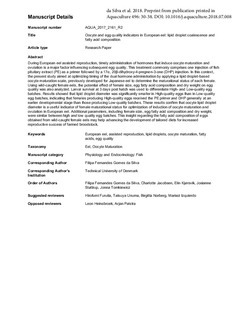| dc.contributor.author | da Silva, Filipa F.G. | |
| dc.contributor.author | Jacobsen, Charlotte | |
| dc.contributor.author | Kjørsvik, Elin | |
| dc.contributor.author | Støttrup, Josianne G. | |
| dc.contributor.author | Tomkiewicz, Jonna | |
| dc.date.accessioned | 2019-04-05T07:44:35Z | |
| dc.date.available | 2019-04-05T07:44:35Z | |
| dc.date.created | 2019-01-14T09:39:02Z | |
| dc.date.issued | 2018 | |
| dc.identifier.citation | Aquaculture. 2018, 496 30-38. | nb_NO |
| dc.identifier.issn | 0044-8486 | |
| dc.identifier.uri | http://hdl.handle.net/11250/2593405 | |
| dc.description.abstract | During European eel assisted reproduction, timely administration of hormones that induce oocyte maturation and ovulation is a major factor influencing subsequent egg quality. This treatment commonly comprises one injection of fish pituitary extract (PE) as a primer followed by a 17α, 20β-dihydroxy-4-pregnen-3-one (DHP) injection. In this context, the present study aimed at optimizing timing of the dual hormone administration by applying a lipid droplet-based oocyte maturation scale, previously developed for Japanese eel to determine the maturational status of each female. Using wild-caught female eels, the potential effect of female size, egg fatty acid composition and dry weight on egg quality was also analyzed. Larval survival at 3 days post hatch was used to differentiate High- and Low-quality egg batches. Results showed that lipid droplet diameter was significantly smaller in High-quality eggs than in Low-quality egg batches, indicating that females producing High-quality eggs received the PE primer and DHP generally at an earlier developmental stage than those producing Low-quality batches. These results confirm that oocyte lipid droplet diameter is a useful indicator of female maturational status for optimization of induction of oocyte maturation and ovulation in European eel. Additional parameters, including female size, egg fatty acid composition and dry weight, were similar between high and low quality egg batches. This insight regarding the fatty acid composition of eggs obtained from wild-caught female eels may help advancing the development of tailored diets for increased reproductive success of farmed broodstock. | nb_NO |
| dc.language.iso | eng | nb_NO |
| dc.publisher | Elsevier | nb_NO |
| dc.rights | Attribution-NonCommercial-NoDerivatives 4.0 Internasjonal | * |
| dc.rights.uri | http://creativecommons.org/licenses/by-nc-nd/4.0/deed.no | * |
| dc.title | Oocyte and egg quality indicators in European eel: lipid droplet coalescence and fatty acid composition. | nb_NO |
| dc.type | Journal article | nb_NO |
| dc.type | Peer reviewed | nb_NO |
| dc.description.version | acceptedVersion | nb_NO |
| dc.source.pagenumber | 30-38 | nb_NO |
| dc.source.volume | 496 | nb_NO |
| dc.source.journal | Aquaculture | nb_NO |
| dc.identifier.doi | 10.1016/j.aquaculture.2018.07.008 | |
| dc.identifier.cristin | 1655845 | |
| dc.description.localcode | © 2018. This is the authors’ accepted and refereed manuscript to the article. Locked until 9.7.2020 due to copyright restrictions. This manuscript version is made available under the CC-BY-NC-ND 4.0 license http://creativecommons.org/licenses/by-nc-nd/4.0/ | nb_NO |
| cristin.unitcode | 194,66,10,0 | |
| cristin.unitname | Institutt for biologi | |
| cristin.ispublished | true | |
| cristin.fulltext | postprint | |
| cristin.qualitycode | 1 | |

